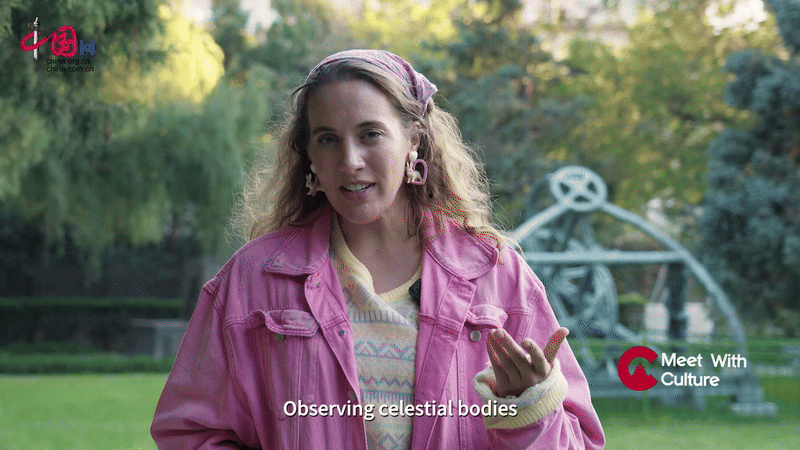We will stay firmly rooted in Chinese culture. We will collect and refine the defining symbols and best elements of Chinese culture and showcase them to the world. We will accelerate the development of China’s discourse and narrative systems, better tell China’s stories, make China’s voice heard, and present a China that is credible, appealing, and respectable.
Meet With Culture | Ancient Observatory: Carrying Chinese Dream of Space Exploration
发布时间:2025-01-02 09:28:36 | 来源:中国网-中国习观 | 作者: | 责任编辑:曹川川

Human beings seem tiny in the vast universe, but their desire to explore the unknown is admirable. "Reaching for the moon" has long been a romantic dream of Chinese people, and they have never stopped the pace to explore the universe.

At the southeast corner of the Jianguomen Overpass in Beijing, there is an ancient tower-like structure made of black bricks, which is 14 meters tall. Atop this city tower are displayed eight ancient astronomical instruments. They seem to recount Chinese people's millennia-old dream of reaching for the stars.


In 1442, the 7th year of the Zhengtong reign of the Ming Dynasty (1368-1644), the government transformed a corner tower of the city into an astronomical observation platform. Astronomical instruments such as armillary spheres and abridged armilla were installed on the platform. In the Qing Dynasty (1644-1911), the tower was transformed into an observatory.

There are eight large astronomical instruments made in the Qing Dynasty on the Beijing Ancient Observatory. Clockwise from the southeast corner, they are the equatorial armillary sphere, sextant, theodolite, altazimuth, zodiacal theodolite, celestial sphere, quadrant, and elaborate equatorial armillary sphere.
These eight astronomical instruments abandoned the original Chinese method of dividing the sphere into 365.25 degrees, and instead adopted the internationally-recognized measurement method of dividing the sphere into 360 degrees, reflecting the endeavors of Chinese astronomers to absorb Western thoughts and keep pace with the times back then.
Back then, the emperors hoped to predict the fate of themselves and their empire through astronomical observations, and then pray for good harvest and prosperity. From the Zhengtong reign of the Ming Dynasty to 1929 during the Republic of China period (1912-1949), the Ancient Observatory undertook the mission of astronomical observations for nearly 500 years, making it the ancient astronomical observation facility with the longest uninterrupted service period in the world.

A sundial is an ancient timekeeping device that indicates the time of day by the position of the shadow of an object exposed to the sun's rays. It usually consists of a vertical stick and a dial plate. The stick vertically erects in the center of the dial plate and points at the North Star. This type is called the equatorial sundial. A sundial uses the position of the shadow of the vertical stick cast by the sun on the dial plate to indicate the time of day.

The exhibition "Observing the Stars for Timekeeping" in the Crape Myrtle Hall focuses on showcasing the astronomical achievements of ancient China. To facilitate star recognition and observation, ancient Chinese astronomers created the constellation system. They divided stars into a number of groups, and each group was named with something on Earth. Such a combination of stars was called a constellation. The establishment of the constellation system laid a profound foundation for China's modern aerospace science and technology.
The exhibition "Western Learning Spreading to the East" in the west wing room mainly displays the tortuous process of Western astronomy being introduced to China since the late Ming Dynasty and its integration and collision with traditional Chinese astronomy.

Today, the Ancient Observatory has become an epitome of historical vicissitudes and a carrier of Chinese civilization. This rich historical legacy left by our ancestors created a brilliant chapter in the history of world astronomy. From the "Two Bombs and One Satellite" to the "Chang'e" lunar probes, the "Zhurong" Mars rover, and the "Tiangong" space station, China's space exploration has always dreamed of exploring the starry sky and will go further to the deeper space.
(Executive Producer: Wang Xiaohui; Production Supervisor: Xue Lisheng; Line Producer: Yu Li; Chief Planner: Ding Suyun, Cao Chuanchuan; Planner: Li Ying; Translator: Liu Haile)

